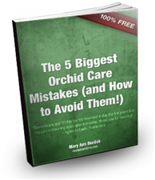 Orchids are famous because of their flowers. With so many varieties of colorful and fragrant flowers, no wonder they are a gardener’s favorite. These plants can even produce blooms over and over for many years. To help you continue having incredible flowers year after year, here are 7 tips you can follow:
Orchids are famous because of their flowers. With so many varieties of colorful and fragrant flowers, no wonder they are a gardener’s favorite. These plants can even produce blooms over and over for many years. To help you continue having incredible flowers year after year, here are 7 tips you can follow:
Making the right cut. Orchids can bloom from several weeks to months when cared for properly. But no matter what you do, the time will come that the flowers will show signs of wilting and drying. When this happens, the immediate and correct thing to do is to cut the flower stalks off. Some may think that this is a weird tip or even a waste of good flowers. But this is exactly what your orchids need and most orchid care resources you’ll find right now will tell you the same thing.
You see, flowering takes out a lot of energy from an orchid. Cutting the flower stalk early on before the blooms totally wilt will save energy and make sure the plant stays healthy. One requirement for orchids to continue to bloom is exactly this. They must be in a perfect and healthy condition.
Be sure that when you cut them use scissors or knives that are sterilized to avoid infection. The location where to cut depends on the size of your plant. A small plant may be cut an inch from its base. If it’s a large orchid, cut it above its node. Then to sterilize it completely, try to put a dab of rubbing alcohol on the cut stem.
Time to propagate. One mistake that most orchid growers make that interrupts the flowering cycle of a plant is when propagating. Remember to only divide and repot new buds when you are sure that your plant can take it. Its age will tell you that. So divide only mature plants. What you have to know is that only ripened pseudobulbs produce flowers. Division interrupts the flowering cycle of an orchid.
Because producing blooms takes a lot of energy, it cannot do both. If you wish to successfully have new blooms the succeeding season then wait for the right time to propagate.
The correct temperature. Orchids need a specific temperature to bloom. Most orchids require a 10 to 20 degree drop of temperature at night to successfully produce flowers. Learn to provide the temperature your orchid needs. Daytime temperature also matters. Too high of a temperature can instantly produce blooms but won’t last as long. Too low of a temperature will cause you the flowering buds – they will freeze and die.
Research and find out the best temperature for your orchid. Different species of orchids have varying temperature needs. Providing the correct temperature will successfully produce blooms for the next flowering season.
Provide enough moisture. In order for buds to produce flowers, they need to be watered regularly. Orchids when budding tend to lose a lot of moisture and although buds are made up of mostly water, it will not be sufficient for the whole plant. Monitor the moisture content of your plant. If they lose too much water the buds may die and fall off. But be sure not to over-water them because this too will kill a plant instantly.
Providing the correct amount of water all year round will also ensure you having blooms for the next year. A good rule to follow is to provide extra moisture when the weather is hot and less when it colder. Wait for the medium or compost to dry out before watering again.
Adequate sunlight. Another essential orchid care tip for re-blooming orchids is providing them adequate light. Any plant needs good amounts of lights in order for it to flower properly. One sure way to make sure they are receiving the correct amount of light is by checking their leaves. Yellowish leaves mean they need more sunlight and dark green to even reddish leaves mean they need less. An uber-healthy plant that can produce great flowers has yellow-green leaves.
The proper fertilizer. Orchids are at their weakest state after blooming. During this time feed your plants the best fertilizer you can find. Experts do not always say what kind of fertilizer this is, so it’s better to check by asking professional growers and propagators. A good plan to follow is fertilizing them once a month. Remember not to fertilize them excessively or you’ll damage or even kill the plant.
Proper nourishment through fertilizers will ensure your plants are healthy enough for the next season of flowering. Take time to research what type is best for your orchids.
Study the flowering cycle. One of the best ways to make your orchids bloom again is to study their flowering cycle. Some orchids can flower only once a year, some several times a year. Learn the best orchid care you can provide based on their cycle, and sure enough you will have long lasting plants that can produce blooms when the right time comes.
No matter what happens, make sure that your orchids are always healthy. This and only this can make sure that your plants will have regular blooms. There is no specific orchid care method for every single species of orchid but if you follow these simple tips, you will have healthy plants ready for their next flowering cycle. Happy blooming!
And to discover even more orchid care tips, download my totally FREE 5-Day Orchid Insider training course by going here: Orchid Care Secrets.




my orchid is full of buds to bloom.all the leaves are yellow.I had it outside under my navel orange tree,I brought it in and sat it in my sink and watered it good and left it drain,I have a saucer under it sitting on my porch,,,,i am in florida what can I do for the yellow leaves,It was very dry when I brought it in and gave it water,,
Hi – it sounds like it needs more water since it was so dry. Here’s a post we did that might give you some good ideas: Save my orchid Thanks! – Mary Ann
Please help! My husband bought me a white phal for mothers day and a few days after it looked sick. I pulled it out of the pot and was completely horrified. It had been sitting in over an inch of water and had really bad root rot, but I was determined to save it. So I did TONS of web searching and I cut off all of the dead roots, sterilizing in between each cut and put cinnamon on all of the open wounds, and changed the medium. It has now been a week and my four remaining “good” roots were withered so I watered them and they did plump up and turn a greener color. But, when I did this I saw very small black spots on the remaining good roots. My question is, could this be some medium stuck to the roots and after already watering is it ok to soak it to see if it comes off? Or should I just cut it off to be safe? The leaves have no spots at all and are still green at the moment but they are droopy as is the stalk which is about 18″ and in bloom, but the flowers are also limp. Should I cut the stalk since I heard that it conserves energy? The plant doesn’t look that bad yet and I believe it can be saved, but the roots really have me concerned as it seems I am having a really hard time permenantly killing this fungus. Please help, anything will be much appriciated!!
I think you should be sure that the roots have a problem before you do any cutting. You don’t want to cut off healthy roots! Maybe take your finger and just see if you can remove the dots or if it’s actually growing on the roots. That might answer the question without over-watering. You could cut the stalk, and that would conserve energy. That sounds like it might be the best option at this point. Save the roots, and the plant can recover. 🙂 Thank you so much! Let us know how it’s going. – Mary Ann
Ok thank you so much. I will try it out and let you know how it pans out. I am desperate to save this plant. Lol.